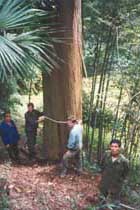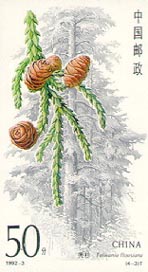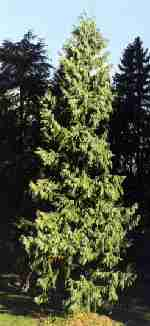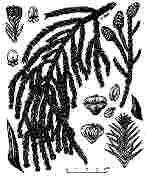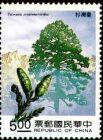Conservation Status

Taiwania cryptomerioides
Hayata 1906
Common names
Taiwania; 台灣杉 tai wan shan [Chinese]; タイワンスギ [Japanese]; Bách tán Đài Loan [Vietnamese].
Taxonomic notes
This is the sole species in Taiwania Hayata 1906, which was formerly assigned to the Taxodiaceae. The type is Taiwan: Nantou Co., Chiayi-Nantou border, Wusungkengshan, N. Konishi s.n., lectotype TI. It has a disjunct distribution, with a group of populations in southwestern China that has sometimes been called Taiwania flousiana Gaussen 1939 or T. yunnanensis Koidz. 1942; and a group of populations on Taiwan, Taiwania cryptomerioides Hayata 1906. Farjon (2010) asserts that since there are no consistent morphological differences between the Taiwan and mainland populations, there is only one species; most authorities agree with this assessment. However, the molecular analysis of Chou et al. (2011) demonstrates a strong genetic differentiation between the mainland and Taiwan populations, with a separation of at least 8 mutation events and an inferred time since separation of 3.25 million years. Within the much more speciose conifer genus Juniperus, this magnitude of genetic differentiation is commonly interpreted as supporting discrimination at species rank; as an example, consider the J. virginiana-complex junipers or the J. poblana-complex junipers, analyzed by Adams (2014) and Adams and Schwarzbach (2012). However, in the absence of morphological differences (and the near-absence of ecological differences), there seems to be little purpose in recognizing infraspecific taxa within Taiwania.
Description
Monoecious evergreen trees with horizontally spreading primary branches. Bark grayish red brown to grayish white, longitudinally fissured, ridges flattened, more or less interlacing, exfoliating in longitudinal narrow thin pieces; lenticels inconspicuous; outer bark 14-15 mm thick, fibrous; with a dark red brown tiered cross section; newly formed periderm brightly red; inner bark 3-6 mm thick, finely fibrous, gradually becoming pale purplish brown after cutting, secreting no white resin; cambium and newly formed phloem inconspicuous. Twigs pendulous, slender, long; winter buds small. Leaves spirally arranged, dimorphic: those of old branchlets densely arranged, subulate, scalelike, upwardly curved, triangular or quadrangular in cross section, with 4-5 stomatal lines present on both surfaces, base short, decurrent, apex acute or obtuse, apiculate; leaves of young trees and new twigs 'S'-shaped, ovate or subulate, ± quadrangular in cross section, laterally compressed, apex straight to incurved, sharply pointed; 1 vascular bundle and 1 resin duct. Pollen cones borne in terminal clusters; microsporophylls many, spirally arranged; microsporangia 2-4, ovate. Seed cones terminal, solitary, erect, nearly sessile, oblong-ovoid, small; bracts rudimentary; ovules 2 per bract axil; cone scales of mature cones numbering 12-20, 8 × 5 mm, cuneately narrowed into a claw and ± flat proximally, broadening distally into an exposed, rounded-spatulate, transversely convex portion, leathery, margin subentire, hyaline, densely and microscopically puberulent with extremely short, 2- or 3-celled hairs (margin thus appearing finely lacerate at low magnification), apical portion small, ± incurved, obtusely truncate, concavely notched, with small, protruding mucro. Seeds oblong, winged, base and apex both notched. Cotyledons 2. Freshly cut sapwood white to pale orange yellow, wood rays inconspicuous (Liu 1970, Fu et al. 1999). See García Esteban et al. (2004) for a detailed characterization of the wood anatomy.
Distribution and Ecology
China: Hubei, Guizhou, Sichuan, Yunnan; Myanmar; Taiwan; Viet Nam: Lao Cai (Fu et al. 1999, Liu 1970, Luu and Thomas 2004). It occurs at 500-2,800 m elevation in "coniferous, broad-leaved, or mixed evergreen valley forests on acid, red, or brown soils in warm or warm temperate regions with high summer and autumn rainfall but drier winters, usually scattered and associated with Chamaecyparis formosensis, C. obtusa var. formosana, Cunninghamia lanceolata, Pinus wallichiana, or Tsuga dumosa, but sometimes forming pure stands" (Fu et al. 1999).
The IUCN classifies this species as "Vulnerable", but that is an optimistic evaluation as it conflates the Taiwan and mainland populations, between which there are substantial genetic differences. The IUCN analysis found that "it has been heavily exploited for its valuable timber and there has been at least a 30-49% population reduction in [historical] time. This is a minimum estimate, and it could well have been higher. The population is now largely stable across much of its range due to conservation efforts in Taiwan, the logging ban in China, and a community conservation programme in Viet Nam. The situation in Myanmar is uncertain as the full extent of its distribution in NE Myanmar is unknown. ... More detailed information from Myanmar could result in a reassessment of Endangered" (Thomas and Farjon 2011).
Remarkable Specimens
The largest known specimen in mainland Asia, discovered in 2021, grows at the Gaoligong Mountain National Nature Reserve in Yunnan. It is approximately 250 cm dbh and 72 m tall, and at the time of discovery was the tallest known tree in China (it has since been displaced by specimens of Abies chensiensis and Pinus bhutanica, as well as by several taller Taiwania) (CGTN 2021, People's Daily Online 2021). Also, McNamara (2001) describes a tree (pictured at right) 41 m tall with a 113 cm dbh.
This was long known to be among the tallest trees in Asia (Liu and Su 1983), but recent years have seen a spate of new discoveries of ever-taller trees. In August 2019 a tree 79.1 m tall was found, climbed, and measured by tape (Facebook post by Rebecca Hsu [徐嘉君] in the Big Tree Seekers group). Ms. Hsu reported "After three hard expeditions, we finally located the tree in June, and tree climbers finished the tape measurement in the window of heavy storm rain on the last Saturday. We named the tree as TaoShan (peach mountain), the nearest peak (3 km in distance) above 3000 m high. The tree height is 79.1 m." There's a video that includes remarkable footage of the forest canopy structure at this site. Then in March 2022 a slightly taller tree was found, over 80 m, also reported on Facebook by Rebecca Hsu. Then, in 2023, Rebecca Hsu found an even taller tree using LIDAR, and a late January field expedition confirmed it to be 84.1 m tall with an 8.5 m girth; this now stands as the tallest known specimen. The same LIDAR exercise identified nearly 1000 trees that are likely more than 65 m tall (Yang 2023).
Taiwania is said to attain an age of 2,000 years (Fu et al. 1999), but no evidence is cited to support this claim.
Ethnobotany
"The wood is easily worked, and is used in building, making furniture and coffins ('Chinese coffin tree'), bridge and boat construction, and paper manufacture" (Fu et al. 1999). In Taiwan, it has become an important species in plantation forestry (Chiu et al. 2010).
Observations
Sample collection: Xinchu Xian: Chienshih Xiang: Chilanshan. Mixed Chamaecyparis, Taiwania and Acer forest. Tree ca. 40 m, DBH 1.2 m (HAST 1999).
Qiqi Pass, near Gongshan in western Yunnan, has small, scattered stands of Taiwania within dense broadleaved forests at 2000-2200 m elevation. Mature trees rise to over 60 m and tower above the surrounding forest (Wharton 2002). A somewhat accessible stand occurs near the village of Maoba in Youyang County, Sichuan; McNamara (2001), describes a 1996 visit to the stand. Cultivated specimens can be seen in the Kunming Botanical Garden, and perhaps elsewhere.
Also see the collection records on iNaturalist.
Remarks
Taiwania is a reference to Taiwan, the type locality; and cryptomerioides means "resembling Cryptomeria"; the foliage, at least, is quite similar.
Citations
Adams, Robert P. 2014. Junipers of the World: The Genus Juniperus. Fourth edition. Trafford Publishing. Brief versions of the descriptions are available online at Adam's website, www.juniperus.org.
Adams, R. P., and A. E. Schwarzbach. 2012. Taxonomy of the multi-seeded, entire leaf taxa of Juniperus section Sabina: sequence analysis of nrDNA and four cpDNA regions. Phytologia 94:350-368.
Anonymous. [no date]. Taiwania Hayata. http://lseb.ibcas.ac.cn/sdb/teyou/typ008.htm, accessed 2003.04.10, now defunct.
CGTN. 2021.12.05. Seeds of China's tallest known tree collected in SW Yunnan Province. https://news.cgtn.com/news/2021-12-05/Seeds-of-China-s-tallest-known-tree-collected-in-SW-Yunnan-Province-15K9OL5kCQ0/index.html, accessed 2022.07.26.
Chiu, Chih-Ming, Gordon Nigh, Ching-Te Chien, and Cheng C. Ying. 2010. Growth patterns of plantation-grown Taiwania cryptomerioides following thinning. Australian Forestry 73(4):246-253.
Hayata, Bunzo. 1906. On Taiwania, a New Genus of Coniferae from the Island of Formosa. J. Linn. Soc., Bot. 37: 330. Available: Biodiversity Heritage Library, accessed 2022.12.27.
Herbarium of the Research Center For Biodiversity, Academia Sinica, Taipei [HAST]. 1999. Database output at http://www2.sinica.edu.tw:8080/hast/eindex.html, accessed 1999.03.15, now defunct.
Liu, T. and H. Su. 1983. Biosystematic studies on Taiwania and numerical evaluations of the systematics of the Taxodiaceae. Taiwan Museum Spec. Pub. Series No. 2.
McNamara, William A. 2001. Three conifers south of the Yangtze. Quarryhill Botanical Garden. http://www.quarryhillbg.org/Publications/3_con/conifers.htm, accessed 2003.04.11, now defunct.
Peoples Daily Online. 2021.10.18. Photographers capture photos of 72-meter-tall tree in Yunnan nature reserve. http://en.people.cn/n3/2021/1018/c90000-9908536.html, accessed 2022.07.26.
Wharton, P. 2002. Botanical exploration on the Yunnan-Myanmar (Burma) border. Davidsonia 13(1/2): 7-14. http://www.ubcbotanicalgarden.org/davidsonia_13_1and2_botanical_exploration.pdf, accessed 2003.04.11, now defunct.
Thomas, P. and A. Farjon. 2011. Taiwania cryptomerioides. The IUCN Red List of Threatened Species 2011: e.T31255A9620141. https://dx.doi.org/10.2305/IUCN.UK.2011-2.RLTS.T31255A9620141.en, accessed on 2022.12.27.
World Conservation Monitoring Centre - Trees. 1999. http://www.unep-wcmc.org/trees/index.html, accessed 1999.04.12, now defunct.
Yang Yuan-ting. 2023.01.31. Taiwan's tallest tree found. Taipei Times. https://www.taipeitimes.com/News/taiwan/archives/2023/01/31/2003793425, accessed 2024.06.11.
Zeng Xiaolian (designer). Stamp issued 1992.03.10. Image available at http://www.bupt.edu.cn/stamp/plant/92_3.htm, accessed 1999.04.12, now defunct.
See also
Do Tien Doan. 2001. Report on the distribution of the Taiwania cryptomerioides in Van Ban District, Lao Cai Province. Available: http://www.fauna-flora.org/docs/hoang_en/VB9_EN.PDF, accessed 2006.03.08, now defunct. This somewhat gloomy survey catalogs an area where almost all native Taiwania have been logged out, but does record 2 trees 1 m dbh, "protected by local people," and documents natural regeneration in the area.
Farjon, Aljos. 2002. Rare and possibly threatened conifers in Vietnam. Available: http://www.fauna-flora.org/docs/hoang_en/G1_EN.PDF, accessed 2006.03.08, now defunct. An appended special report on "Taiwania cryptomerioides Hayata in Vietnam" addresses the species' taxonomy, conservation status and distribution, with a detailed discussion of whether the species is native or naturalized in Vietnam, including relevant field observations.
Farjon 2005 (as a monotypic genus).
Huang 1994 (the Flora of Taiwan).
Luu and Thomas 2004 provide a description, range map, conservation status, drawings and photos, and a wealth of additional information.
Wang Jiaguo, Li Xiaofang, An Mingtai, et al., 2015. Interspecific associations among main tree species in Taiwania cryptomerioides community in Leigong Mountain. Journal of Northwest Forestry University 30(4):78-83 [have not located this one].
The species account at Threatened Conifers of the World.
